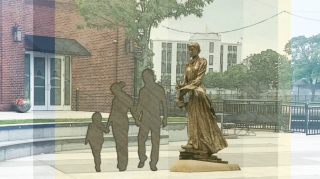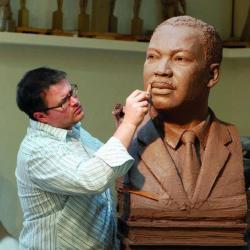Forten's Awakening

Project Proposal Information
Defining and Communicating the Legacy of Charlotte Forten:
In considering a monument to Charlotte Forten it is important to consider both subject and place. Forten was a poet, a journalist, a writer, and an educator, but she was always, and most essentially, an abolitionist. In reading Forten’s journals and sources like Polly Longworth’s “I Charlotte Forten Black and Free”, Forten’s every action and her every word were in service of the fight to end slavery and to create a path toward freedom and equality for her race. Her legacy is two-fold. First that the fight for liberty for all is humankind’s most important effort. And second, her belief in the power of education and the written word as allies in this fight. A successful memorial to Charlotte Forten must incorporate and communicate these themes.
There is also the need to consider the Forten tribute within the greater context of the current levels of representation of women of color in public art. If we are to acknowledge that Forten’s recognition is tardy in the extreme and that her visage should be as recognizable as that of Ben Franklin, Alexander Hamilton, or Frederick Douglas, then the argument could be made that the most fitting tribute to Forten should be done in a traditional style, like some of the best-known monuments of her male peers. Further, an effective likeness is essential.
Her expression and posture should communicate an outward reserve mixed with the keen fires of ambition and righteous defiance. Her gaze is one of observation and accounting and above all resolve and determination.
Charlotte Forten was both of her time and exceptional. She came from a family of distinguished abolitionists, and she was a free negro with access to education. She understood the society she was born into was designed to limit her impact because of her race and gender, but Forten was unwavering in her effort to be an agent of change. She was determined to use every available means to engage herself in the fight against slavery. She writes in her journal, “What, I as Negro and a Woman besides might do to help my fellow man was far from clear. Yet I was determined to be prepared when some avenue of opportunity opened and to this end worked furiously to educate myself.” She pursued her education with urgency and agency, a successful tribute must convey that education, both her own and the lessons she taught others, was not a passive pursuit for Forten it was a weapon in her fight for justice. Education and writing were her source of momentum, her tools of resistance, the means with which she elevated others, and her legacy.
Education as Agency:
Forten was deeply aware that preventing access to education was a vital tool of oppression within the system of slavery. She recognized that educating herself was an act of rebellion against the institution of slavery and that each person of color she educated furthered the resistance and gave people of color the kind of agency over their future that slavery stood in opposition to. When she was eventually able to educate freed slaves on St. Helena Island this too was a strike against oppression and a foundational act meant to assist in securing a new life of equality and freedom for those who had so unjustly had their freedom stolen from them. Forten recognized that whites wanted black people to fail at freedom. It was education that would protect their success.
Charlotte Forten understood her privilege as freeperson, but she was also outspoken and vigilant in her identification of the racial prejudice still very much present in the Massachusetts of her time and the region’s own complicit history regarding the institution of slavery.
Connection to Community:
This is why the placement of the Forten monument in Salem is so important. While a tribute to Forten on St. Helena Island would be stirring and effective, it was Salem that Forten wrote of in her journals, recounting stories of prejudice and fuming at Massachusetts cowardly treatment of victims of the Fugitive Slave Act. A memorial to Forten in Salem gives the city a permanent conscientious reporter. A witness who in her own time saw the progress Massachusetts had made in the transition from the physical heart of the slave trade to a free city that was still burdened with prejudice. With this tribute, Forten resumes her post in Salem and stands in permanent observance of the city’s continued gains -- the vibrant immigrant-founded neighborhood of the Point and murals celebrating Dominican heritage are evident achievements near the Forten statute – as well as the persistent and pernicious struggle of achieving racial equality.
Forten was an active participant in her community. Her tribute should be the same. It should be accessible and a source of education and information. Observers should leave the monument inspired to learn more about Forten and her work. The memorial should continue Forten’s work in spreading education and bringing awareness to the cause of liberty.
Design Options:
Steven Whyte Sculpture Studios has developed two design options based on these themes.
“I Will Be Heard”
At the heart of the monument is a life-size cast bronze figure of Charlotte Forten, positioned on an elevated platform constructed of books. This base symbolizes Forten’s belief that education was the key to both her personal elevation and the collective progress of the Negro race. For Forten, education was not merely a means to acquire knowledge but a potent weapon in the fight against the institution of slavery. The books are sculpted to reflect some of the works Forten frequently referenced in her work. The documents, petitions, and slave narratives found on her grandfather’s shelves: “American Slavery as It Is” by The Reverend Theodore Dwight Weld; “Appeal” by David Walker; and “An Appeal in Favor of the Class of Americans Called Africans.” Their inclusion provides added details to Forten’s thought process and background while it prompts visitors to seek out these important texts.
The sculpture conveys a sense of determination and intelligence, captured in the figure’s resolute expression and watchful gaze.
Forten dedicated herself to holding not only the city of Salem but also the entire state of Massachusetts, the North, and ultimately the United States accountable for the injustice of slavery. Her pen and writings were her weapons of choice, serving as a testament to her unyielding resolve in the fight to abolish slavery. These elements are central to the monument’s design. Forten used her writing to educate, to serve as testimony and to persuade. Her writings were a form of active agitation. This design conveys this dynamism and shows Forten’s writings in a permanent state of movement -- a timeless source of inspiration. Sculpted details on these papers could include selections from Forten’s journals depicting key moments in Salem’s history, as well as Forten’s poems, and articles. The papers appear to be in permanent motion communicating that Forten’s words live on well beyond her own life.
The base of the figure come together in sharp point conveying a sense of forward momentum that echoes Forten’s own determination and driving spirit to bring an end to slavery.
Artist Bio

Whyte has been a professional sculptor for more than thirty years and has installed more than sixty life-size or larger figures in England, the United States and Asia. A former vice president of the Royal Society of Portrait Sculptors, a selection of Whyte's portraits have been acquired by the Smithsonian Institution for the National Portrait Gallery’s and Museum of African American History and Culture’s permanent collections. Among his numerous honors, Whyte was named the 2016 Sports Artist of the Year, was the 2021 recipient of the National Sculpture Society’s, Stanley Bleifeld Memorial Award and the 2022 Champion of the Arts for Monterey County.
His accomplishments as an artist have given him ample experience in public memorials with a strong connection to the community. He has created numerous monuments including the 40-foot Aggie War Hymn Monument, for Texas A&M University; The National Military Tribute for Bob Hope in San Diego; Jumbo the Elephant for Tufts University, A Monument to John Steinbeck’s Cannery Row in Monterey, California, Joseph Vaughn for Furman University in South Carolina, and Women’s Column of Strength located in San Francisco - named one of the top monuments of the year in 2017 by Smithsonian Magazine.

